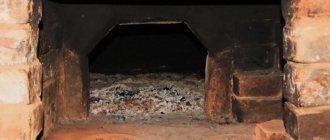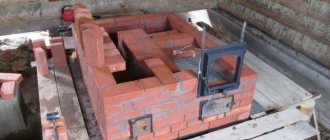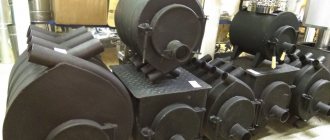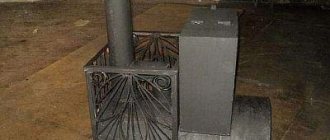Progressive humanity never ceases to come up with new designs that are intended for one purpose - to make human existence as comfortable as possible. One of the relative novelties was a stove with a very unusual name “buleryan”. In general, its inventor had only one task. He needed to create a small-sized, mobile, efficient, but inexpensive device that could cope with all responsibilities. For example, with heating the temporary housing of lumberjacks leading a nomadic lifestyle (or rather, work). The assigned “mission” was completed with honor. And for those who do not yet know about all the new products, but want to be aware of what is appearing on the market, now all that remains is to find out how the Buleryan works, understand the principle of its operation, consider the positive characteristics of the design and, if any, its weaknesses.
Furnace structure and its elements
The design of Buleryan stoves is designed for the use of solid fuel - firewood, less often coal or compressed wood waste is used.
The design of such stoves is extremely simple, which allows you to assemble them yourself using a minimal set of tools. Collapse Contents:
- Principle of operation
- Dimensions
- About water bullers
- Bullers without pipes
- What is the efficiency and can it be increased?
- Conclusion
A stove-potbelly stove of the Buleryan type looks like a steel barrel with pipes, which can be located at the top and/or bottom of the structure. It combines the pyrolysis type of combustion and the functions of a convection heater. The heat generated during fuel combustion immediately goes into the pipes (air ducts), which increases its productivity by up to 80-85%.
Construction of the Buleryan stove in the photo (sectional view)
Structural design of the Buleryan furnace:
- The largest part of the structure is the combustion compartment of the placed solid propellant element (occupies 85% of the volume) - the processes of primary ignition and generation of pyrolysis products occur.
- Compartment for afterburning fuel (25% of the internal volume of the unit) - pyrolysis products enter, after which the residual fuel burns to form a flame, the process is accompanied by the release of high temperature.
- Injectors - tubes for supplying air to the afterburning chamber (necessary for carrying out the combustion reaction of pyrolysis products).
- Pipes for the convection process - this element of the Buleryan pyrolysis furnace is made from thick pipes made of metal. They receive heat released during the combustion process, which exits into the room through an opening in the pipes in the form of streams of warm air.
- Regulators - this part of the oven consists of two mandatory elements necessary to regulate the operation of the unit - the damper and the throttle on the door. A function is implemented that allows you to regulate the air supply to the afterburner chamber. The temperature of the released air is controlled.
- The chimney (with or without a container for collecting condensate) is a function of removing combustion products.
- Ash pan (located at the bottom of the structure).
Design Features
Relative new products on the market always arouse increased interest among potential buyers. Bullers are no exception to the rule, so you need to learn about the advantages and disadvantages of the devices, and also understand the difference between bullerans and brenerans.
Advantages of a Canadian invention
After considering how buleryan is designed and how it works, it’s time to consider its merits. The device is quite different from traditional ovens. The list of advantages of the design includes:
Separately, it should be noted its safety for people. Buleryan, operating in gasification mode, will not allow even owners traveling around the house in the dark, half asleep, to get seriously burned.
Disadvantages of Buleryans
Even unique inventions have disadvantages, but everyone will assess their seriousness differently. The disadvantages of Canadian devices include several weak points. This:
- Work on one of the types of fuel. The ideal is firewood, which is absolutely logical for a device invented for the comfortable existence of lumberjacks.
- Highly toxic condensate that forms inside chimneys. However, this disadvantage is also inherent in other types of stoves that operate autonomously.
- The need for dry fuel for efficient operation in gasification mode.
- Some loss of gas not involved in the combustion process, burning smell.
The relative disadvantages include the constant emission of smoke during operation due to incomplete combustion of wood. For this reason, it is recommended to build a chimney with a height of 5-7.5 m. Burnout of metal is a “inevitable evil”, but with correct operation of the device it can last 5-10 years or more. Long-livers are known - structures that have been working properly for 40 years.
Buleryan and Breneran
How do buleryan and breneran work, what is the difference between these units? Virtually none. These are the two brands under which such stoves are produced. In Europe, the equipment appeared in the 1980s. The Germans were the first to produce new models of stoves. Their products were (and are) called in an original way - Bullerjan Free Flow.
About a decade later, in 1993, the production of stoves was established in Russia, but in 2005 the official manufacturer (the Laotherm company) decided to rename the buleryans to brenerans. The reasons for this move are some improvements made to the original design and an increase in the warranty period to 30 months.
Principle of operation
The modern Buleryan potbelly stove is used in different areas - for heating a home, industrial or gardening buildings. Buleryan's thoughtful device makes it possible to obtain maximum thermal output from solid fuel. The Buleryan wood stove works according to the following principle:
- The required volume of firewood is loaded into the firebox (you can add a little paper or ignition mixture to facilitate the process of engulfing in flames).
- After the fire burns confidently, it is necessary to limit the air flow.
- The process of pyrolysis occurs - ignition under the influence of a secondary air flow.
Schematic representation of the operating principle
The heat generated during the active process of smoldering and residual combustion of wood fuel and pyrolysis products then enters the air heat exchanger. To ensure complete tightness of the combustion chamber, the pipes at the base of the heat exchanger, if the stove is assembled with your own hands, must be welded together with sheet iron.
Important! The amount of heat generated by the unit is sufficient to create a fully functioning distribution of pipes that heat other rooms or spaces.
Gases heated by fire release thermal energy (up to 90%) into the curved pipes of the structure. If you correctly calculate the power of the stove and the area of the room it heats, then you will need to add fuel 2-3 times a day.
Popular manufacturers
Buleryan stoves are produced by various factories in many countries, Russia and neighboring countries are no exception. 3 manufacturers have gained the most popularity:
Kyiv Novaslav
A company from Ukraine that specializes in the production of stove equipment for saunas, baths, and heating of various rooms. Novaslav equipment operates according to the basic design of the original models, but is better adapted for heating compared to standard stoves of this type. Available in a number of series:
- Vancouver 01 type up to 200 m3, maximum power 11 kW. Weight 97 kg. Upon request, it can be equipped with a thermal glass door. Area of use: premises with a volume of up to 200 m3. The cost ranges from 16,000 to 20,000 rubles.
- Montreal, 02 type up to 400 m3 - this model range stands out for its increased power of up to 18 kW, in comparison with Vancouver, with a low weight of 127 kg and small dimensions, it is capable of heating a room with a volume of up to 400 m3. The cost ranges from 26,000 to 30,000 rubles.
- Quebec, 03 type up to 600 m3 - this type is best suited for production needs. Upon request, the door can be equipped with a glass thermal insert. The maximum heating area is 260 m2. The cost ranges from 30,000 to 40,000 rubles.
- Toronto, 04 type up to 1000 m3 – high power heat generator. The power is sufficient to heat an area of up to 350 m2. The cost starts from 43,000 rubles.
- Ontario, 05 type up to 1300 m3 - a convection oven of the highest power, which is sold by the company. The power of the equipment reaches 45 kW; it is easy for them to heat a volume of up to 1300 m³. The cost starts from 44,000 rubles.
The lineup
The stoves look aesthetically pleasing and can serve as an element of a design solution. The company also produces a variety of Buleryan fireplace stoves.
NMK
A metalworking company from Novosibirsk produces furnace equipment and accessories. NMK produces ovens using convection, Siberia BV Buleryan. The equipment of this company is ideal for heating any premises. The following equipment can be purchased:
- Siberia BV 120 is best suited for industrial premises: greenhouses, dryers, etc. The highest temperature of heated air is 80 °C. At a single load, in gas-generating mode it will work for up to 10 hours. The largest heating volume is 120 m³. Cost 11,500–13,000 rubles.
- Siberia BV 180 – works on any solid fuel mass: wooden logs, coal, cardboard packaging or briquettes. A thermometer is installed to regulate the temperature of the exhaust gases. The stove is undemanding to the quality of the fuel mass. Cost 14,000–15,000 rubles.
- Siberia BV 480 - is distinguished by a modified design of convection pipes; the standard circular cross-section is replaced with a rectangular one. It is distinguished by optimal dimensions of the firebox door and an eccentric type lock, which ensures tight contact with the body. Heats up to 480 m³. Cost 17,000–19,000 rubles.
- Siberia BV 720 - with a mass of 157 kg, this equipment is a powerful heat generator producing energy of 49 kW. Suitable for heating large warehouse areas and premises with a large number of living rooms. Cost 23,500–26,000 rubles.
Models "Sibir BV"
Eurosib
A company from Russia that specializes in the manufacture of structures entirely made of metal. A distinctive feature is the presence of a cooking surface in some models. The company sells a few modifications:
- Klondike NV Buleryan stove - their capacity ranges from 100 to 1200 m3. They were developed for effective heating with buleryan in harsh winter conditions. At a single load, the operating mode is about 10 hours; they are not too demanding on the quality of the fuel mass. Cost from 12,000 to 46,000 rubles.
Buleryan Klondike-NV
- Buleryan convection-type long-burning wood fuel stoves with a Tulinka NVU hob. A distinctive feature is that there are no convection pipes that stick out on other models. Instead, a cooking panel with holes for convection is mounted on top. Suitable for heating individual houses and this configuration of the Buleryan stove is ideal for a summer residence. Maximum heating volume 150 m3. The cost of the Buleryan stove ranges from 7,500 to 12,500 rubles.
Conclusion
Owners of individual buildings or houses should pay close attention to the Buleryan stove. Using a Buleryan stove for your dacha is the optimal solution
After all, it has high efficiency, is capable of operating on a single load for up to 12 hours (this eliminates the need to add fuel late at night), does not require conservation, and is easy to operate and maintain.
Dimensions
Canadian Buleryan stoves have the following size range:
- Height – 71-96 cm.
- Width – 49-75 cm.
- Depth – 69-150 cm.
By groups:
- Group 00 – height 71 cm, width – 49 cm, depth – 69 cm.
- Group 01 – height 75 cm, width – 56 cm, depth – 82 cm.
- Group 02 – 85 cm, width – 85 cm, depth – 99 cm.
- Group 03 – height 90 cm, width – 62 cm, depth – 112 cm.
Buleryan type 01 (Vancouver)
The choice of group depends on the individual characteristics of the structure where the device is supposed to operate. There are also two groups that are recommended to be installed in production areas:
- Group 04 – height 96 cm, width – 71 cm, depth – 134 cm.
- Group 05 – height – 96 cm, width 75 cm, depth – 150 cm.
Example of Buleryan from group 04 (Toronto)
Power also needs to be taken into account. Depending on the model, they produce 6-45 kW. The volume of the room that can be heated using the unit (m3) is 100-1300. Number of pipes – 7-16. The smallest Buleryan is capable of heating a small cottage (up to 100 m3) or a greenhouse.
If you liked the article, please share it
Previously on the topic:
Share
About water bullers
Buleryan can also carry out heating and water heating at the same time. Boilers equipped with a water circuit are used in homes and factories. Buleryan - a stove with combined functions in design and design is similar to the conventional modification, which uses air convection for full heating.
Example of water buleryan
Device Features:
- There are pipes around the combustion chamber.
- The basic principle of operation is chemical processes: pyrolysis or gas generation.
- The pipes are filled not with hot air, but with heated coolant liquid.
The Buleryan system furnace with a water circuit operates as follows:
- Pipes (convection) in the lower part have a collector (lower and upper).
- An outlet is specially mounted on the lower of the collectors, which is necessary to return the liquid to the system.
- The upper element has a pipe that is required to supply coolant liquid to the system.
- The water or other liquid heat carrier used in the system gradually heats up. This happens during the process of firing the furnace.
- The desired pressure is created (selected by setting).
- Liquid circulation occurs under the influence of physicochemical factors and its rise to a height of 7-8 meters.
- The coolant fluid moves through pipes and is supplied to heating devices (batteries, convectors), which are located in rooms (living rooms, production workshops or greenhouses).
The cooled liquid heat source is returned back to the system using an outlet on the lower collector.
In this case, the gas formed during the combustion of solid fuel takes part in the heating process. For this purpose, the design of the furnace provides two, rather than one, combustion chambers - in one, the main fuel is burned (firewood, pressed sawdust or coal briquettes), in the second, the process of afterburning of gases occurs.
Water buller connection diagram
After heating the firewood combustion compartment, it is recommended to switch the boiler to gas generation mode. In this phase of operation, the fuel does not burn, but smolders. This allows you to increase the heat transfer time, but the system will function autonomously. Feature - the efficiency remains the same as when burning wood or other solid fuel. A Buleryan home stove with a water heating system allows you to obtain hot water for domestic needs if the pipes are connected to a special container. Water heats up to 100 degrees in 30-40 minutes, depending on the model chosen for use, which requires about 2.5 kW of energy.
Exploitation
In order for the heating system to operate with maximum heat transfer, the instructions must be strictly followed.
Reasons for low performance may include:
- Insufficient chimney height;
- Illiterate installation of the stove (the distance from the floor is acceptable within 40-50 centimeters);
- Too many connected heating radiators (the oven should not operate at maximum).
To prevent the circuit from defrosting, it is necessary to completely drain the water from the system after finishing work.
Since the buler was originally developed for heating the living quarters of lumberjacks, the ideal fuel would be firewood - dry, hardwood. It is desirable that these are solid logs with a size corresponding to the length of the fuel chamber. Coal can be used as fuel, but is not recommended.
The firebox door must be tightly closed during operation - no gaps are allowed. Ash should remain in the firebox the entire time the stove is operating.
As already mentioned, the product has several names, although in essence it is the same device. Buleryan was renamed by the official manufacturer about fifteen years ago, due to the introduction of some improvements to the original design. As a result, the warranty period for the device has increased to two and a half years.
Bullers without pipes
What is a Buleryan stove without pipes? This is a modification of a conventional stove with a heat shield, to which an afterburner has been added. Inventor – Professor Butakov I.N. The design system and operating principle of Butakov furnaces are similar to conventional Buleryan, but the design is devoid of complex components and elements, which makes it possible to reduce the size and dimensions.
Manufacturing principles
It is quite understandable to want to try to make a buleryan oven with your own hands. You should immediately take into account that trying to build a furnace without experience in welding and plumbing is pointless. Even though a detailed description and drawing of the Buleryan stove can be easily found on the Internet.
If such a decision is nevertheless made, it is worth remembering that in a buleryan one of the most complex elements is the front wall with the door: the latter must ensure complete sealing, and its production will have to be ordered, otherwise you will not have to count on high-quality operation of the stove.
A list of necessary materials and tools can also be found on a specialized website or forum for stove makers.
What is the efficiency and can it be increased?
The efficiency of Buleryan, depending on the size and power, as well as the correctness of the settings, is 70-90%. These figures can be increased by 3-5% by installing no more than 6 pipes per unit. Important: Efficiency may decrease if the furnace power is less than the maximum permissible area of the house or other building for the selected model. The Buleryan stove has the following disadvantages that can negatively affect this indicator:
- The use of coal reduces the heat output.
- The efficiency is as promised only when using dry firewood.
- 60% of gases go into the chimney.
- It is necessary to correctly regulate the process of adding and limiting air access.
If all the disadvantages of buleryan are taken into account, the efficiency will increase. Installing glass for the Buleryan stove (in the door of the combustion chamber) will create the effect of a fireplace in the house.
Criterias of choice
Performance
The higher the power, the more expensive they are. Let's compare the price of Buleryan furnaces of the Eurosib brand. A model that heats up to 100 m3 costs approximately from 9,000 to 11,000 rubles, and equipment for 1,200 m³ is estimated from 42,000 to 45,000 rubles.
Availability of a hob
Equipment with cooking panels has less power and is intended for heating small rooms. However, in cost they are 10-15% more expensive than equipment without such panels.
Manufacturer
This parameter has little effect on the price of the equipment. Buleryan heating stoves of equal power cost almost the same.
Other factors
The cost of equipment may also increase due to unpredictable factors, such as the need for additional construction work or the complexity of delivery. These factors are difficult to predict due to the fact that they depend on each specific case.
Conclusion
Canadian technology, which is used to manufacture heating boilers and their analogues in other countries, is an effective source of heat with low consumption of solid fuel. Correctly configured system will allow you to maintain optimal temperature in rooms of any size. It is important to adhere to the rule: the ratio of the power of the unit and the size of the premises so that the efficiency is optimal. To heat several rooms and/or water for domestic needs at once, it is recommended to choose special systems that use a liquid heat exchanger and gas generation process for their operation. Additionally, the Buleryan stove for a greenhouse or house with a water heating circuit uses the principle of pyrolysis in its operation.
Kinds
For heating
According to the method of operation, there are two types:
- with water circuit. Perfectly suitable for private homes. The specificity of the operation of furnaces lies in the heating of a liquid (usually water, less often antifreeze) that circulates through the heating system, which warms the house. 90% of the combustion energy goes to heating the liquid and only 10% to the air.
Water buleryan
- convection type, they heat the air, which is evenly distributed through air ducts throughout the rooms.
Standard model
Advantages of the Buleryan heating stove:
- large volume heating;
- uniform heating;
- soot and smoke do not enter the room;
- compact size;
- rapid heating;
- efficiency.
With hob
For residential premises, stoves are available with a convenient modification - a cooking surface. The Buleryan stove with a hob is used for the following purposes:
- heating an area up to 150 m2;
- Cooking and heating food, a 6 liter capacity pan boils for 30 minutes.
To achieve heating efficiency, it is recommended to install them in rooms without partitions. The installation point must provide air convection. This Buleryan is just perfect for a dacha.
Model with hob (VESUVI)
Furnace Breneran AOT-6 type 00
Structurally they have a number of features:
- 2-chamber structure - in one, gas generation processes are carried out, in the other, afterburning of the gaseous mixture is carried out.
- Injectors – afterburners are installed in the convection flow channels to increase the efficiency of the equipment.
- 2 operating modes. They function in the form of generating combustible gas and like a conventional furnace. With the second type, food can be cooked on the hob.
- Productivity – the equipment is capable of heating an area of up to 150 m2. The oven will operate for up to 6 hours on one load.
- The working principle is the use of gas generation processes. As a result of combustion, oxidation of the fuel mass occurs - this generates CO. It enters the afterburning chamber, which increases the amount of thermal energy received.
- Heating occurs due to convection - air comes from the room due to pipes located 2/3 in the firebox - this gives rapid heating. Heated air arrives almost instantly.
Buleryan wood-burning cooking and heating stoves are suitable for individual houses, especially when natural gas or electrical energy is unavailable.
First steps
First, we need to make the frame of our entire Buleryan stove - it is an interweaving of curved pipes that form an air heater and the future firebox. Use a pipe bender and bend them to a radius of 225 mm. The length of each pipe is 120 cm - this is more than enough. The pipes are welded together with metal strips to create a stable base for our stove. There should be no holes on the sides, otherwise smoke will penetrate into the heated rooms.
What's bad about it?
Yes, the bullers have no visible flaws. That’s what they call it: a stove without flaws. But there is still one hidden one, and a serious one.
Any organic fuel burns, releasing the so-called. reaction water. It is a complete analogue of metabolic water formed in living organisms: it is released during the breakdown of organic molecules. Due to the low temperature in the furnace, there is more reaction water in the exhaust of Buleryan than other slow-burning furnaces; in them this water partially participates in pyrolysis.
The second point is the mineral components of wood. Buller sellers present as an advantage the fact that the wood in the buller burns without even leaving ash. But there is ash in the wood initially, and in bullers, ash particles fly out into the chimney.
The third is hydrocarbon radicals. These are chemically very active remnants of organic molecules that have not completely decomposed. All this taken together reduces the efficiency of the buller by only 5-7% and by volume constitutes the same share of its exhaust. But for household Buleryans, these percentages turn out to be truly lethal.
Let's remember Carnot's formula. If you take a pyrolysis boiler with 1500 degrees in the combustion chamber and 300 in the exhaust, it will show an efficiency of 80%. For Buleryan, the same 80% is obtained at 600 and 120, respectively.
The reaction water from the pyrolysis boiler does not have time to condense in the chimney and dissipates without a trace in the atmosphere. The ash settles under the firebox. From where it has to be raked out from time to time. It contains purely mineral salts suitable for fertilizer. The boiler also produces organic radicals in small quantities, but already 1-2 m from the mouth of the chimney they are oxidized by atmospheric oxygen to carbon dioxide and water, because they were formed at high temperatures and are very light, of low molecular weight
Not so in a buller. The reaction water immediately after the economizer falls into condensate. Each drop of it is a thin film rolled into a lump, and the physical chemistry of thin films is strikingly different from that of massive aggregates of matter. And then there are ash particles, heavy organic radicals. As a result, not just dirty water settles into the sump, but a cocktail of monstrous toxicity, carcinogenicity and God knows what else.
This crap (without quotes) needs to go somewhere. Leaving the end of the “pipe that goes to the ground” open will gradually undermine the foundation, and you won’t be able to eat vegetables from the garden. Slowly take it out and pour it out - the properties of the Buleryan sludge condensate are such that it cannot be hidden from the SES and environmentalists, with all that it implies.
That’s why bullers are also called greenhouse stoves. They are most often installed in greenhouses without an economizer (see figure). Flowers, early and all-season vegetables are highly profitable products; it will not be expensive not only to put up with worse efficiency, but also to change the entire stove in a year or two or three.
Installing a buller without an economizer
True, the exhaust from such a buller still smells, but greenhouses themselves emit methane, ethylene, and so on in the same spirit. Therefore, according to sanitary rules, they cannot be built near residential buildings, so the smoke from the buller does not even require a separate “solution to the issue.”
Some cunning flower growers, especially in places poor in water, judging that tulips, roses and carnations are not eaten, and many plants with luxurious flowers are poisonous in themselves, install bullers according to the full scheme, and the sludge condensate, after slightly filtering, is put into drip irrigation systems. However, tomato and strawberry experiments of this kind always end in resuscitation of buyers, investigation and loud scandals with sanctions, or even prison.
Recommendations for use
- The chimney pipe for your stove should be assembled in the opposite direction relative to the movement of exhaust gases, which practically reduces to zero the likelihood of wood resins leaking through it during operation. The latter in this case will return to the chimney and burn out in it.
- Comply with fire safety requirements when arranging the installation site of the stove and the surrounding area.
- Be sure to provide for the possibility of simplified installation/dismantling of the chimney for regular cleaning of resins and soot deposited on the walls.
- The Buleryan stove must be configured according to your preferences.
- Remember to periodically inspect the top of the chimney to remove any resin build-up that appears.
- The optimal furnace mode is empirically selected, which is characterized by maximum combustion time and minimum degree of clogging of the smoke exhaust pipe. To operate the unit in the specified mode, the channel must be cleaned at least twice a season.
- Before putting firewood into the firebox, it is advisable to pre-dry it over the stove.
- In addition to logs, to save money, it is recommended to add briquettes made from sawdust and wood chips to the firebox.
Checking the welding machine
The main tool in the manufacture of a furnace is a welding machine. First you need to make sure it is working properly. If you have minimal experience in such work, we recommend that you first practice on training seams. At the final stage of assembling the stove, you will have to scald it around the entire perimeter. You need to be prepared for this. In addition, do not forget to check the metal and pipes for weldability. Materials may need to be replaced.
How I upgraded Buleryan
How I upgraded Buleryan
How I upgraded Buleryan
How I upgraded Buleryan
How I upgraded Buleryan
How I upgraded the Buleryan
The design features of the stove in question are such that it can initially distribute oxygen efficiently and evenly within itself. The tubes at the bottom draw in cold oxygen, and the heated air is discharged from those installed at the top. If desired, you can provide forced oxygen circulation.
I took tubes of a suitable diameter and welded adapters from them to the holes of the stove pipe located below. I plugged the adapter at one end.
The other side was connected to the fan.
I decided to use “snail” fan models. To ensure their operation, in my case, a 90-watt motor at 2800 rpm was enough.
The results are excellent - after modification, Buleryan began to work even more efficiently.
I’m also thinking about connecting corrugated cables to the upper outlets and spreading them in different directions - we’ll get a full-fledged heating system.
You can customize the instructions in your own way. I will be happy to read your suggestions and maybe even put something into practice.
My instructions will help you assemble a reliable, efficient, durable and productive stove with your own hands.
Blueprints
Blueprints
Blueprints
Blueprints
Blueprints
Blueprints
Blueprints
Blueprints
Blueprints
Blueprints
Blueprints
Blueprints
Blueprints
Blueprints
Blueprints
Blueprints
Blueprints
Blueprints
Blueprints
Blueprints
Management
Management
Management
Management
Management
Management
Management
Management
Management
Management
Management
Management
Management
Management
Management
Management
Management
Management
Management
Buleryan
Buleryan
Buleryan
Buleryan
Good luck!
Flaws
- When loading wet firewood, resins will form as it burns, so you should only use completely dry fuel.
- When selecting wood for fuel, you need to choose species that do not emit resins.
- In the second furnace in Buleryan, only 70% of the generator gases are burned.
- If the chimney was not insulated before the Breneran sauna stove was installed, then condensation may be released, which will reduce the performance of the device.
- Due to the metal body of the device, in addition to the additional protective coating and sheathing of the surrounding walls with basalt insulation, a distance from the walls of at least half a meter will also be required, which is not always convenient in small spaces.
- Due to dust getting into the pipe opening, an unpleasant odor may occur when the oven heats up.
- The rooms in which the stove is located require daily cleaning and ventilation, since during its operation charged ions are formed that can have a negative effect on the human body.
About heating a private house
Okay, the reader may say, but you need to warm up! Yes, but stove heating is used mainly in private households, and there water heating is pure prejudice, a stereotype of “centralized” thinking. For the efficiency of a central thermal power plant, indeed, the heat capacity of the coolant is of paramount importance, otherwise it will cool down before it reaches subscribers.
What about in a private house? What, should we run a line from the kitchen or furnace around the entire area to the living room/bedroom? Isn’t it easier to disperse the warm air through the rooms, which the bubbler gives, as they say, from the top? Judge for yourself:
- Air ducts can be made with a simple tool from cheap materials: tin, plasterboard, plywood, just cardboard, but pipes are expensive, they need to be bent, boiled, soldered.
- No registers, expansion tank, fittings, or automation are needed.
- You can forget about fistulas and leaks once and for all.
- Ductwork with fans and louvers does not require a design or permit. It is enough to calculate for yourself which section should go into which room.
- Heat transfer into the walls (and this is up to 15% of heat loss through water) is zero; here the poor thermal conductivity of the air works to our advantage.
- Install adjustable blinds at the exits - here you have easy, quick temperature control in rooms. It’s better not to compare it with setting up water heating.
- If you place the exit blinds on the walls farthest from the window above the floor, then the air will give up its heat to the room by the time it gets to where it can heat the street. And everyone knows how batteries in window sills increase the entropy of the Universe.
- The same technique will also provide a warm floor without any additional costs or work.
- The walls are straight, there are no deformities in sight - design the interior as you please.











